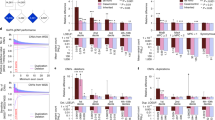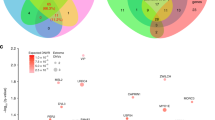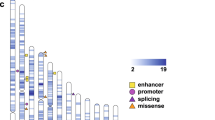Abstract
Autism spectrum disorder (ASD) represents a set of complex neurodevelopmental disorders with large degrees of heritability and heterogeneity. We sequenced 136 microcephaly or macrocephaly (Mic–Mac)-related genes and 158 possible ASD-risk genes in 536 Chinese ASD probands and detected 22 damaging de novo mutations (DNMs) in 20 genes, including CHD8 and SCN2A, with recurrent events. Nine of the 20 genes were previously reported to harbor DNMs in ASD patients from other populations, while 11 of them were first identified in present study. We combined genetic variations of the 294 sequenced genes from publicly available whole-exome or whole-genome sequencing studies (4167 probands plus 1786 controls) with our Chinese population (536 cases plus 1457 controls) to optimize the power of candidate-gene prioritization. As a result, we prioritized 67 ASD-candidate genes that exhibited significantly higher probabilities of haploinsufficiency and genic intolerance, and significantly interacted and co-expressed with each another, as well as other known ASD-risk genes. Probands with DNMs or rare inherited mutations in the 67 candidate genes exhibited significantly lower intelligence quotients, supporting their strong functional impact. In addition, we prioritized 39 ASD-related Mic–Mac-risk genes, and showed their interaction and co-expression in a functional network that converged on chromatin remodeling, synapse transmission and cell cycle progression. Genes within the three functional subnetworks exhibited distinct and recognizable spatiotemporal-expression patterns in human brains and laminar-expression profiles in the developing neocortex, highlighting their important roles in brain development. Our results indicate some of Mic–Mac-risk genes are involved in ASD.
This is a preview of subscription content, access via your institution
Access options
Subscribe to this journal
Receive 12 print issues and online access
$259.00 per year
only $21.58 per issue
Buy this article
- Purchase on Springer Link
- Instant access to full article PDF
Prices may be subject to local taxes which are calculated during checkout



Similar content being viewed by others
References
de la Torre-Ubieta L, Won HJ, Stein JL, Geschwind DH . Advancing the understanding of autism disease mechanisms through genetics. Nat Med 2016; 22: 345–361.
Lai MC, Lombardo MV, Baron-Cohen S . Autism. Lancet 2014; 383: 896–910.
Xia K, Guo H, Hu Z, Xun G, Zuo L, Peng Y et al. Common genetic variants on 1p13.2 associate with risk of autism. Mol Psychiatry 2014; 19: 1212–1219.
Iossifov I, Ronemus M, Levy D, Wang Z, Hakker I, Rosenbaum J et al. De novo gene disruptions in children on the autistic spectrum. Neuron 2012; 74: 285–299.
Neale BM, Kou Y, Liu L, Ma’ayan A, Samocha KE, Sabo A et al. Patterns and rates of exonic de novo mutations in autism spectrum disorders. Nature 2012; 485: 242–245.
O’Roak BJ, Vives L, Girirajan S, Karakoc E, Krumm N, Coe BP et al. Sporadic autism exomes reveal a highly interconnected protein network of de novo mutations. Nature 2012; 485: 246–250.
Sanders SJ, Murtha MT, Gupta AR, Murdoch JD, Raubeson MJ, Willsey AJ et al. De novo mutations revealed by whole-exome sequencing are strongly associated with autism. Nature 2012; 485: 237–241.
De Rubeis S, He X, Goldberg AP, Poultney CS, Samocha K, Cicek AE et al. Synaptic, transcriptional and chromatin genes disrupted in autism. Nature 2014; 515: 209–215.
Iossifov I, O'Roak BJ, Sanders SJ, Ronemus M, Krumm N, Levy D et al. The contribution of de novo coding mutations to autism spectrum disorder. Nature 2014; 515: 216–221.
Jiang Y-h YuenRK, Jin X, Wang M, Chen N, Wu X et al. Detection of clinically relevant genetic variants in autism spectrum disorder by whole-genome sequencing. Am J Human Genet 2013; 93: 249–263.
Yuen RK, Thiruvahindrapuram B, Merico D, Walker S, Tammimies K, Hoang N et al. Whole-genome sequencing of quartet families with autism spectrum disorder. Nat Med 2015; 21: 185–191.
Turner TN, Hormozdiari F, Duyzend MH, McClymont SA, Hook PW, Iossifov I et al. Genome sequencing of autism-affected families reveals disruption of putative noncoding regulatory DNA. Am J Hum Genet 2016; 98: 58–74.
Yuen RK, Merico D, Cao H, Pellecchia G, Alipanahi B, Thiruvahindrapuram B et al. Genome-wide characteristics of de novo mutations in autism. NPJ Genomic Med 2016; 1: 160271–1602710.
C Yuen RK, Merico D, Bookman M, L Howe J, Thiruvahindrapuram B, Patel RV et al. Whole genome sequencing resource identifies 18 new candidate genes for autism spectrum disorder. Nat Neurosci 2017; 20: 602–611.
Ku C, Polychronakos C, Tan E, Naidoo N, Pawitan Y, Roukos D et al. A new paradigm emerges from the study of de novo mutations in the context of neurodevelopmental disease. Mol Psychiatry 2013; 18: 141–153.
Krumm N, O’Roak BJ, Shendure J, Eichler EE . A de novo convergence of autism genetics and molecular neuroscience. Trends Neurosci 2014; 37: 95–105.
McCarthy SE, Gillis J, Kramer M, Lihm J, Yoon S, Berstein Y et al. De novo mutations in schizophrenia implicate chromatin remodeling and support a genetic overlap with autism and intellectual disability. Mol Psychiatry 2014; 19: 652–658.
Kataoka M, Matoba N, Sawada T, Kazuno AA, Ishiwata M, Fujii K et al. Exome sequencing for bipolar disorder points to roles of de novo loss-of-function and protein-altering mutations. Mol Psychiatry 2016; 21: 885–893.
Willsey AJ, Sanders SJ, Li MF, Dong S, Tebbenkamp AT, Muhle RA et al. Coexpression networks implicate human midfetal deep cortical projection neurons in the pathogenesis of autism. Cell 2013; 155: 997–1007.
Parikshak NN, Luo R, Zhang A, Won H, Lowe JK, Chandran V et al. Integrative functional genomic analyses implicate specific molecular pathways and circuits in autism. Cell 2013; 155: 1008–1021.
Cristino AS, Williams SM, Hawi Z, An JY, Bellgrove MA, Schwartz CE et al. Neurodevelopmental and neuropsychiatric disorders represent an interconnected molecular system. Mol Psychiatry 2014; 19: 294–301.
Sanders SJ, Xin H, Willsey AJ, Ercan-Sencicek AG, Samocha KE, Cicek AE et al. Insights into autism spectrum disorder genomic architecture and biology from 71 risk loci. Neuron 2015; 87: 1215–1233.
Ben-David E, Shifman S . Combined analysis of exome sequencing points toward a major role for transcription regulation during brain development in autism. Mol Psychiatry 2013; 18: 1054–1056.
Chang J, Gilman SR, Chiang AH, Sanders SJ, Vitkup D . Genotype to phenotype relationships in autism spectrum disorders. Nat Neurosci 2015; 18: 191–198.
Krishnan A, Zhang R, Yao V, Theesfeld CL, Wong AK, Tadych A et al. Genome-wide prediction and functional characterization of the genetic basis of autism spectrum disorder. Nat Neurosci 2016; 19: 1454–1462.
O’Roak BJ, Vives L, Fu W, Egertson JD, Stanaway IB, Phelps IG et al. Multiplex targeted sequencing identifies recurrently mutated genes in autism spectrum disorders. Science 2012; 338: 1619–1622.
O'Roak BJ, Stessman HA, Boyle EA, Witherspoon KT, Martin B, Lee C et al. Recurrent de novo mutations implicate novel genes underlying simplex autism risk. Nat Commun 2014; 5: 5595.
Wang T, Guo H, Bo X, Stessman H, Wu H, Coe BP et al. De novo genic mutations among a Chinese autism spectrum disorder cohort. Nat Commun 2016; 7: 13316.
Stessman HA, Xiong B, Coe BP, Wang T, Hoekzema K, Fenckova M et al. Targeted sequencing identifies 91 neurodevelopmental-disorder risk genes with autism and developmental-disability biases. Nat Genet 2017; 49: 515–526.
van Bon BW, Coe BP, Bernier R, Green C, Gerdts J, Witherspoon K et al. Disruptive de novo mutations of DYRK1A lead to a syndromic form of autism and ID. Mol psychiatry 2016; 21: 126–132.
Fombonne E, Roge B, Claverie J, Courty S, Fremolle J . Microcephaly and macrocephaly in autism. J Autism Develop Disorders 1999; 29: 113–119.
Sacco R, Gabriele S, Persico AM . Head circumference and brain size in autism spectrum disorder: A systematic review and meta-analysis. Psychiatry Res 2015; 234: 239–251.
Thompson BA, Tremblay V, Lin G, Bochar DA . CHD8 is an ATP-dependent chromatin remodeling factor that regulates beta-catenin target genes. Mol Cell Biol 2008; 28: 3894–3904.
Abrahams BS, Arking DE, Campbell DB, Mefford HC, Morrow EM, Weiss LA et al. SFARI Gene 2.0: a community-driven knowledgebase for the autism spectrum disorders (ASDs). Mol Autism 2013; 4: 36.
Li H, Durbin R . Fast and accurate short read alignment with Burrows–Wheeler transform. Bioinformatics 2009; 25: 1754–1760.
Li H, Handsaker B, Wysoker A, Fennell T, Ruan J, Homer N et al. The sequence alignment/map format and SAMtools. Bioinformatics 2009; 25: 2078–2079.
McKenna A, Hanna M, Banks E, Sivachenko A, Cibulskis K, Kernytsky A et al. The Genome Analysis Toolkit: a MapReduce framework for analyzing next-generation DNA sequencing data. Genome Res 2010; 20: 1297–1303.
Wang K, Li M, Hakonarson H . ANNOVAR: functional annotation of genetic variants from high-throughput sequencing data. Nucleic Acids Res 2010; 38: e164–e164.
Li J, Cai T, Jiang Y, Chen H, He X, Chen C et al. Genes with de novo mutations are shared by four neuropsychiatric disorders discovered from NP denovo database. Mol Psychiatry 2016; 21: 290–297.
Li J, Jiang Y, Wang T, Chen H, Xie Q, Shao Q et al. mirTrios: an integrated pipeline for detection of de novo and rare inherited mutations from trios-based next-generation sequencing. J Med Genet 2015; 52: 275–281.
Lek M, Karczewski KJ, Minikel EV, Samocha KE, Banks E, Fennell T et al. Analysis of protein-coding genetic variation in 60,706 humans. Nature 2016; 536: 285–291.
He X, Sanders SJ, Liu L, De Rubeis S, Lim ET, Sutcliffe JS et al. Integrated model of de novo and inherited genetic variants yields greater power to identify risk genes. Plos Genet 2013; 9: e1003671.
Cai T, Yang L, Cai W, Guo S, Yu P, Li J et al. Dysplastic spondylolysis is caused by mutations in the diastrophic dysplasia sulfate transporter gene. Proc Natl Acad Sci USA 2015; 112: 8064–8069.
Yu P, Yang W, Han D, Wang X, Guo S, Li J et al. Mutations in WNT10B are identified in individuals with oligodontia. Am J Hum Genet 2016; 99: 195–201.
Guo S, Yang L, Liu H, Chen W, Li J, Yu P et al. Identification of novel compound mutations in PLA2G6-Associated neurodegeneration patient with characteristic MRI imaging. Mol Neurobiol 2016.
Krumm N, Turner TN, Baker C, Vives L, Mohajeri K, Witherspoon K et al. Excess of rare, inherited truncating mutations in autism. Nat Genet 2015; 47: 582–588.
Gulsuner S, Walsh T, Watts AC, Lee MK, Thornton AM, Casadei S et al. Spatial and temporal mapping of de novo mutations in schizophrenia to a fetal prefrontal cortical network. Cell 2013; 154: 518–529.
Samocha KE, Robinson EB, Sanders SJ, Stevens C, Sabo A, McGrath LM et al. A framework for the interpretation of de novo mutation in human disease. Nat Genet 2014; 46: 944–950.
Kang HJ, Kawasawa YI, Cheng F, Zhu Y, Xu XM, Li MF et al. Spatio-temporal transcriptome of the human brain. Nature 2011; 478: 483–489.
Li TB, Wernersson R, Hansen RB, Horn H, Mercer J, Slodkowicz G et al. A scored human protein-protein interaction network to catalyze genomic interpretation. Nat Methods 2017; 14: 61–64.
Langfelder P, Horvath S . WGCNA: an R package for weighted correlation network analysis. BMC Bioinformatics 2008; 9: 559.
Miller JA, Ding SL, Sunkin SM, Smith KA, Ng L, Szafer A et al. Transcriptional landscape of the prenatal human brain. Nature 2014; 508: 199–206.
Magnani D, Morle L, Hasenpusch-Theil K, Paschaki M, Jacoby M, Schurmans S et al. The ciliogenic transcription factor Rfx3 is required for the formation of the thalamocortical tract by regulating the patterning of prethalamus and ventral telencephalon. Human Mol Genetics 2015; 24: 2578–2593.
Low LK, Liu XB, Faulkner RL, Coble J, Cheng HJ . Plexin signaling selectively regulates the stereotyped pruning of corticospinal axons from visual cortex. Proc Natl Acad Sci USA 2008; 105: 8136–8141.
Huang N, Lee I, Marcotte EM, Hurles ME . Characterising and predicting haploinsufficiency in the human genome. PloS Genet 2010; 6: e1001154.
Petrovski S, Wang Q, Heinzen EL, Allen AS, Goldstein DB . Genic intolerance to functional variation and the interpretation of personal genomes. PloS Genet 2013; 9: e1003709.
Lim ET, Raychaudhuri S, Sanders SJ, Stevens C, Sabo A, MacArthur DG et al. Rare complete knockouts in humans: population distribution and significant role in autism spectrum disorders. Neuron 2013; 77: 235–242.
Toma C, Torrico B, Hervas A, Valdes-Mas R, Tristan-Noguero A, Padillo V et al. Exome sequencing in multiplex autism families suggests a major role for heterozygous truncating mutations. Mol Psychiatry 2014; 19: 784–790.
Hoischen A, Krumm N, Eichler EE . Prioritization of neurodevelopmental disease genes by discovery of new mutations. Nat Neurosci 2014; 17: 764–772.
Liu L, Sabo A, Neale BM, Nagaswamy U, Stevens C, Lim E et al. Analysis of rare, exonic variation amongst subjects with autism spectrum disorders and population controls. PloS Genet 2013; 9: e1003443.
Campbell CD, Eichler EE . Properties and rates of germline mutations in humans. Trends Genet 2013; 29: 575–584.
Durak O, de Anda FC, Singh KK, Leussis MP, Petryshen TL, Sklar P et al. Ankyrin-G regulates neurogenesis and Wnt signaling by altering the subcellular localization of beta-catenin. Mol Psychiatry 2015; 20: 388–397.
Turner TN, Sharma K, Oh EC, Liu YFP, Collins RL, Sosa MX et al. Loss of delta-catenin function in severe autism. Nature 2015; 520: 51–56.
Pilorge M, Fassier C, Le Corronc H, Potey A, Bai J, De Gois S et al. Genetic and functional analyses demonstrate a role for abnormal glycinergic signaling in autism. Mol Psychiatry 2016; 21: 936–945.
Tilot AK, Bebek G, Niazi F, Altemus JB, Romigh T, Frazier TW et al. Neural transcriptome of constitutional Pten dysfunction in mice and its relevance to human idiopathic autism spectrum disorder. Mol Psychiatry 2016; 21: 118–125.
Frazier TW, Embacher R, Tilot AK, Koenig K, Mester J, Eng C . Molecular and phenotypic abnormalities in individuals with germline heterozygous PTEN mutations and autism. Mol Psychiatry 2015; 20: 1132–1138.
Sowers LP, Loo L, Wu Y, Campbell E, Ulrich JD, Wu S et al. Disruption of the non-canonical Wnt gene PRICKLE2 leads to autism-like behaviors with evidence for hippocampal synaptic dysfunction. Mol Psychiatry 2013; 18: 1077–1089.
Durand CM, Perroy J, Loll F, Perrais D, Fagni L, Bourgeron T et al. SHANK3 mutations identified in autism lead to modification of dendritic spine morphology via an actin-dependent mechanism. Mol Psychiatry 2012; 17: 71–84.
Hamilton PJ, Campbell NG, Sharma S, Erreger K, Hansen FH, Saunders C et al. De novo mutation in the dopamine transporter gene associates dopamine dysfunction with autism spectrum disorder. Mol Psychiatry 2013; 18: 1315–1323.
Griesi-Oliveira K, Acab A, Gupta AR, Sunaga DY, Chailangkarn T, Nicol X et al. Modeling non-syndromic autism and the impact of TRPC6 disruption in human neurons. Mol Psychiatry 2015; 20: 1350–1365.
Stessman HA, Bernier R, Eichler EE . A genotype-first approach to defining the subtypes of a complex disease. Cell 2014; 156: 872–877.
Bernier R, Golzio C, Xiong B, Stessman HA, Coe BP, Penn O et al. Disruptive CHD8 mutations define a subtype of autism early in development. Cell 2014; 158: 263–276.
Niehrs C, Acebron SP . Mitotic and mitogenic Wnt signalling. EMBO J 2012; 31: 2705–2713.
Durak O, Gao F, Kaeser-Woo YJ, Rueda R, Martorell AJ, Nott A et al. Chd8 mediates cortical neurogenesis via transcriptional regulation of cell cycle and Wnt signaling. Nat Neurosci 2016; 19: 1477–1488.
Acknowledgements
We thank the patients and their families for their participation in this study. The project was funded by the National Basic Research Program of China (2012CB517900) and the National Natural Science Foundation of China (31571301, 81330027, 31400919 and 31671114). HG was supported by the Young Talent Lifts Project of CAST.
Author information
Authors and Affiliations
Corresponding authors
Ethics declarations
Competing interests
The authors declare no conflict of interest.
Additional information
Supplementary Information accompanies the paper on the Molecular Psychiatry website
Supplementary information
Rights and permissions
About this article
Cite this article
Li, J., Wang, L., Guo, H. et al. Targeted sequencing and functional analysis reveal brain-size-related genes and their networks in autism spectrum disorders. Mol Psychiatry 22, 1282–1290 (2017). https://doi.org/10.1038/mp.2017.140
Received:
Revised:
Accepted:
Published:
Issue Date:
DOI: https://doi.org/10.1038/mp.2017.140
This article is cited by
-
Brief Report: Evidence of Autism Spectrum Disorder Caused by a Mutation in ATRX Gene: A Case Report
Journal of Autism and Developmental Disorders (2024)
-
A mouse model of ATRX deficiency with cognitive deficits and autistic traits
Journal of Neurodevelopmental Disorders (2023)
-
Genetic and environmental contributions to co-occurring physical health conditions in autism spectrum condition and attention-deficit/hyperactivity disorder
Molecular Autism (2023)
-
Landscape of mSWI/SNF chromatin remodeling complex perturbations in neurodevelopmental disorders
Nature Genetics (2023)
-
WDR62-deficiency Causes Autism-like Behaviors Independent of Microcephaly in Mice
Neuroscience Bulletin (2023)



